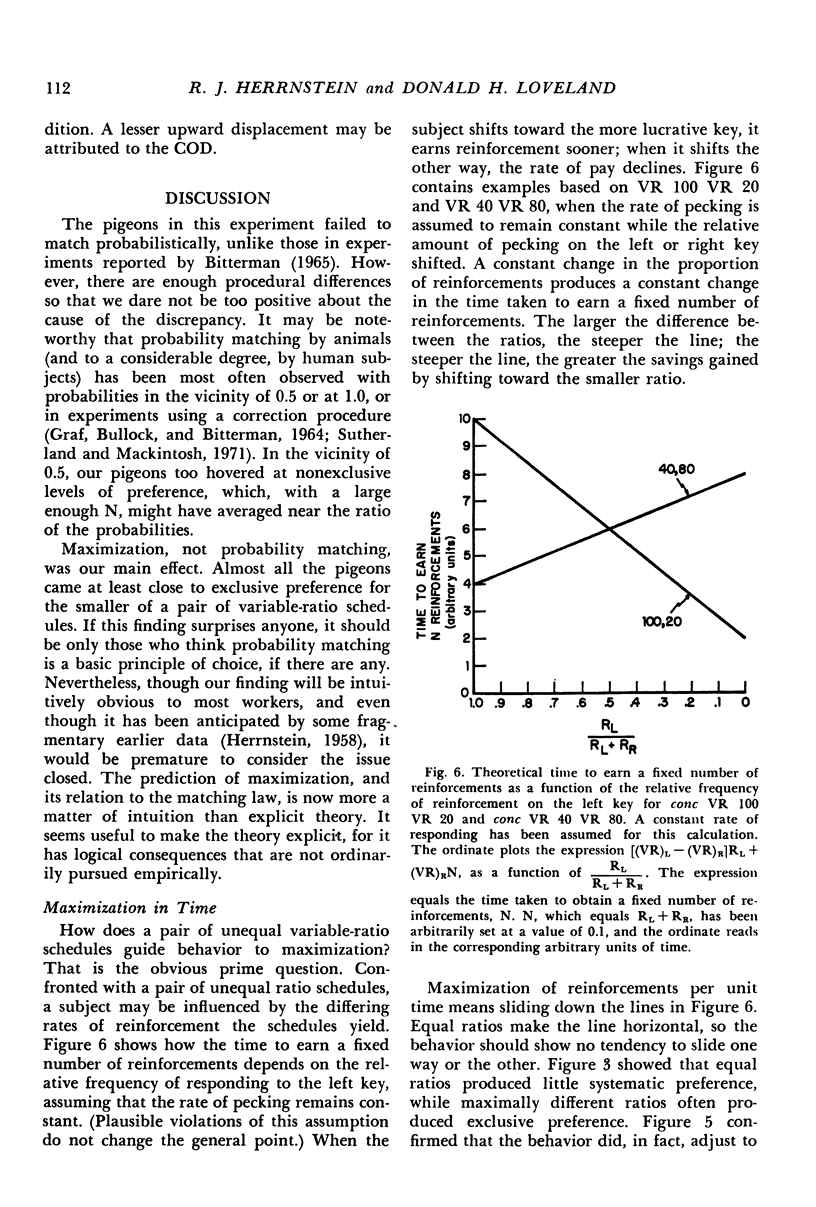Abstract
Pigeons on concurrent variable-ratio variable-ratio schedules usually, though not always, maximize reinforcements per response. When the ratios are equal, maximization implies no particular distribution of responses to the two alternatives. When the ratios are unequal, maximization calls for exclusive preference for the smaller ratio. Responding conformed to these requirements for maximizing, which are further shown to be consistent with the conception of reinforcement implicit in the matching law governing relative responding in concurrent interval schedules.
Full text
PDF









Selected References
These references are in PubMed. This may not be the complete list of references from this article.
- ANGER D. The dependence of interresponse times upon the relative reinforcement of different interresponse times. J Exp Psychol. 1956 Sep;52(3):145–161. doi: 10.1037/h0041255. [DOI] [PubMed] [Google Scholar]
- BITTERMAN M. E. PHYLETIC DIFFERENCES IN LEARNING. Am Psychol. 1965 Jun;20:396–410. doi: 10.1037/h0022328. [DOI] [PubMed] [Google Scholar]
- Catania A. C., Reynolds G. S. A quantitative analysis of the responding maintained by interval schedules of reinforcement. J Exp Anal Behav. 1968 May;11(3 Suppl):327–383. doi: 10.1901/jeab.1968.11-s327. [DOI] [PMC free article] [PubMed] [Google Scholar]
- FLESHLER M., HOFFMAN H. S. A progression for generating variable-interval schedules. J Exp Anal Behav. 1962 Oct;5:529–530. doi: 10.1901/jeab.1962.5-529. [DOI] [PMC free article] [PubMed] [Google Scholar]
- GRAF V., BULLOCK D. H., BITTERMAN M. E. FURTHER EXPERIMENTS ON PROBABILITY-MATCHING IN THE PIGEON. J Exp Anal Behav. 1964 Mar;7:151–157. doi: 10.1901/jeab.1964.7-151. [DOI] [PMC free article] [PubMed] [Google Scholar]
- Herrnstein R. J. On the law of effect. J Exp Anal Behav. 1970 Mar;13(2):243–266. doi: 10.1901/jeab.1970.13-243. [DOI] [PMC free article] [PubMed] [Google Scholar]
- Nevin J. A. Interval reinforcement of choice behavior in discrete trials. J Exp Anal Behav. 1969 Nov;12(6):875–885. doi: 10.1901/jeab.1969.12-875. [DOI] [PMC free article] [PubMed] [Google Scholar]
- Nevin J. A. On the form of the relation between response rates in a multiple schedule. J Exp Anal Behav. 1974 Mar;21(2):237–248. doi: 10.1901/jeab.1974.21-237. [DOI] [PMC free article] [PubMed] [Google Scholar]
- REYNOLDS G. S. On some determinants of choice in pigeons. J Exp Anal Behav. 1963 Jan;6:53–59. doi: 10.1901/jeab.1963.6-53. [DOI] [PMC free article] [PubMed] [Google Scholar]
- Shimp C. P. Probabilistically reinforced choice behavior in pigeons. J Exp Anal Behav. 1966 Jul;9(4):443–455. doi: 10.1901/jeab.1966.9-443. [DOI] [PMC free article] [PubMed] [Google Scholar]
- Shimp C. P. Reinforcement of least-frequent sequences of choices. J Exp Anal Behav. 1967 Jan;10(1):57–65. doi: 10.1901/jeab.1967.10-57. [DOI] [PMC free article] [PubMed] [Google Scholar]
- Silberberg A., Williams D. R. Choice behavior on discrete trials: a demonstration of the occurrence of a response strategy. J Exp Anal Behav. 1974 Mar;21(2):315–322. doi: 10.1901/jeab.1974.21-315. [DOI] [PMC free article] [PubMed] [Google Scholar]


